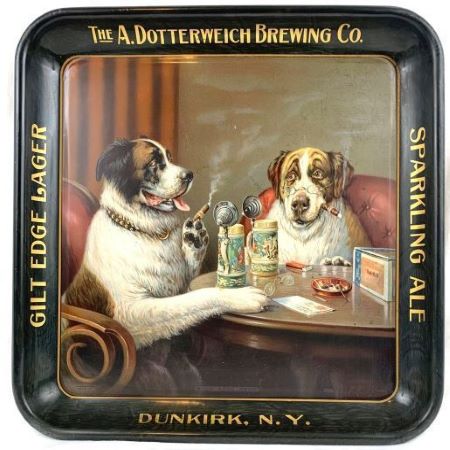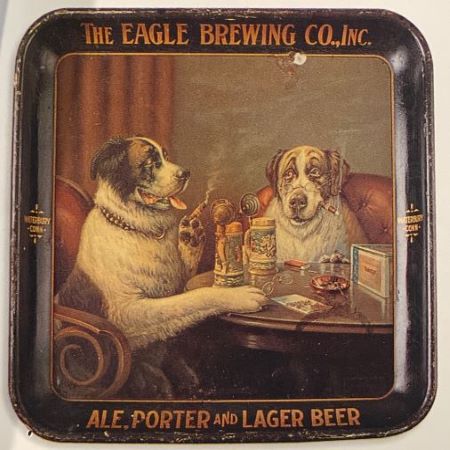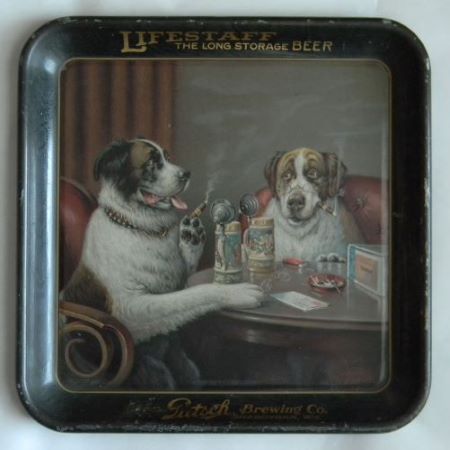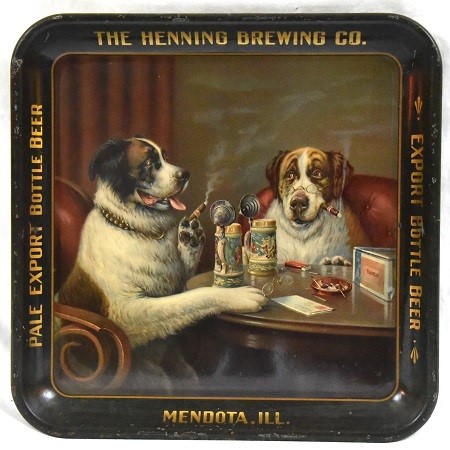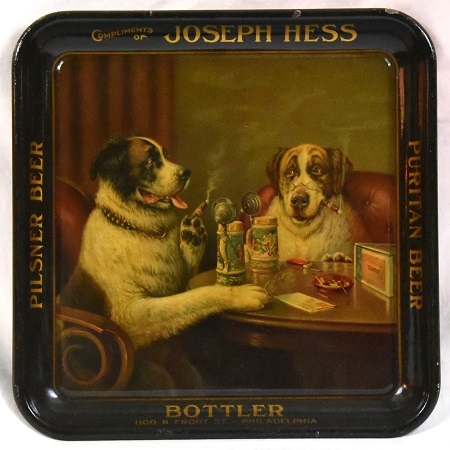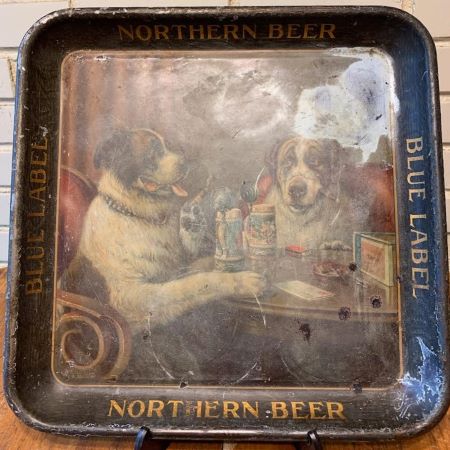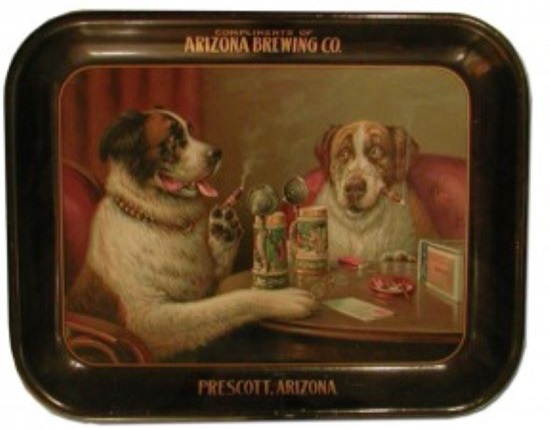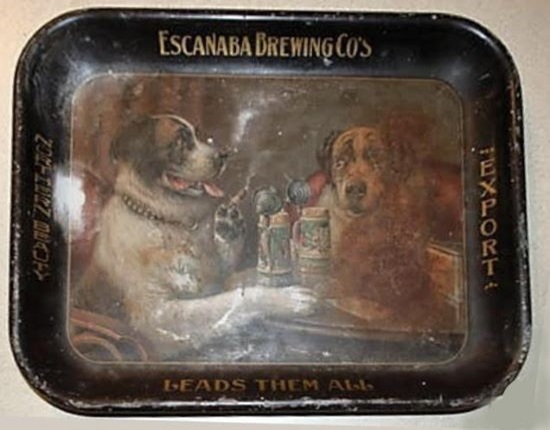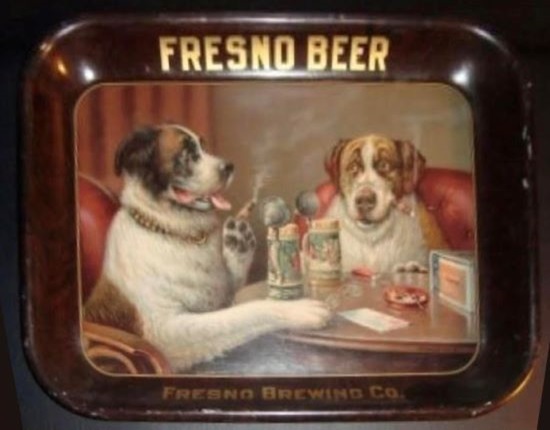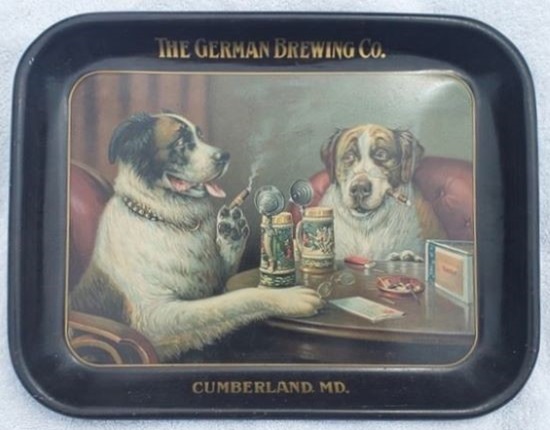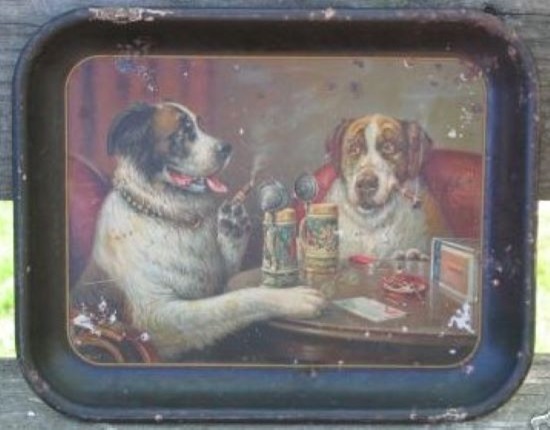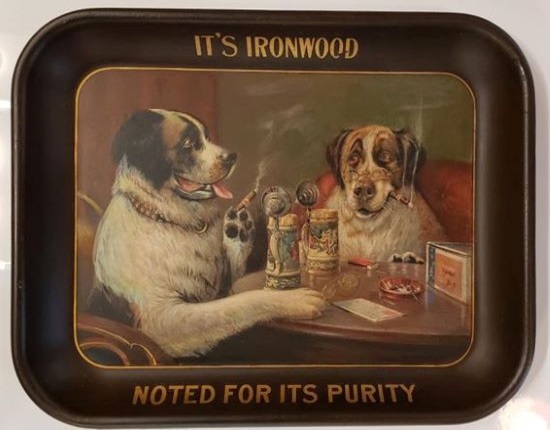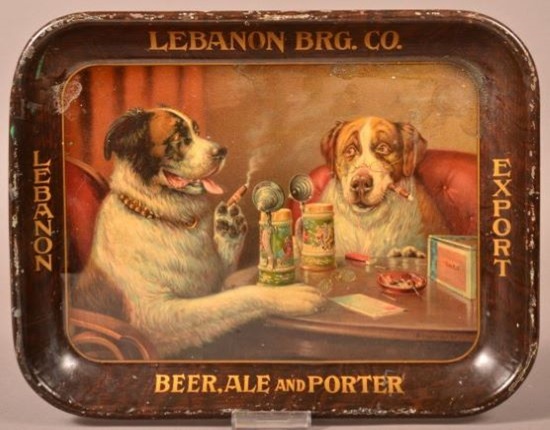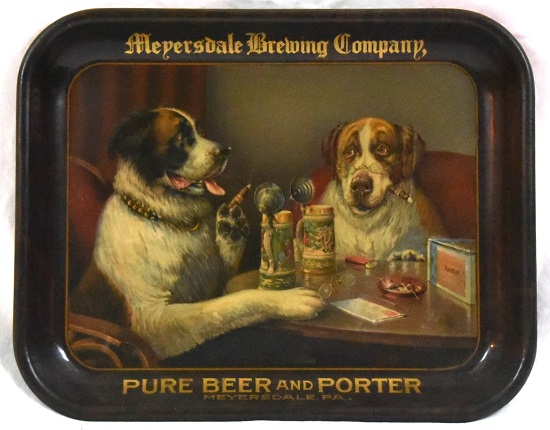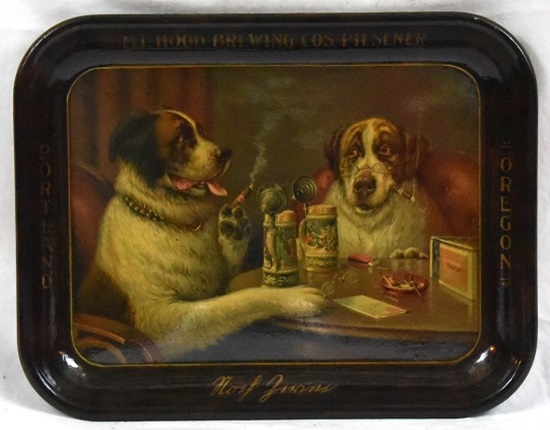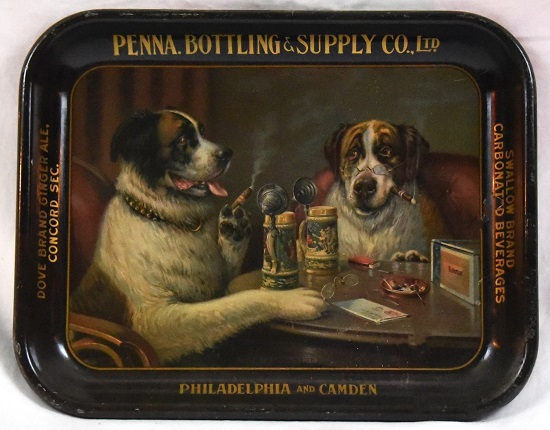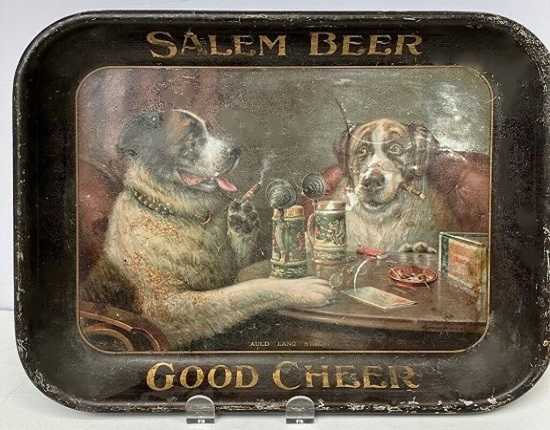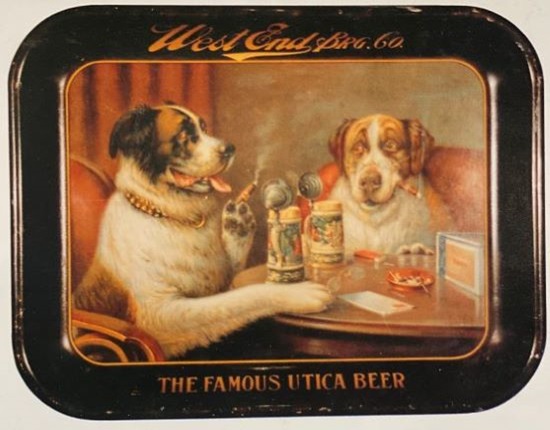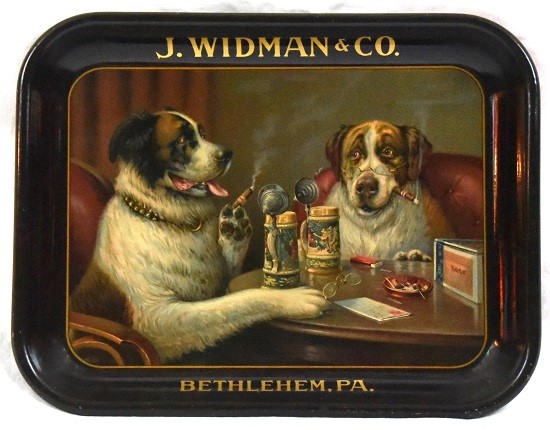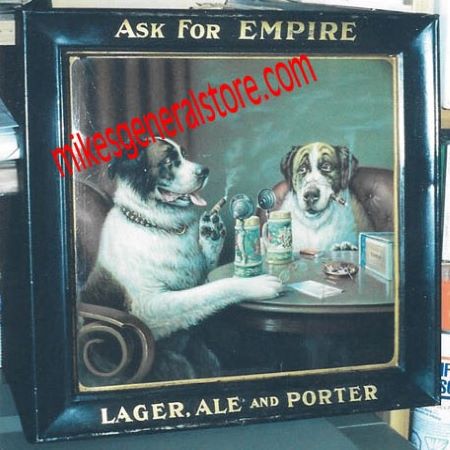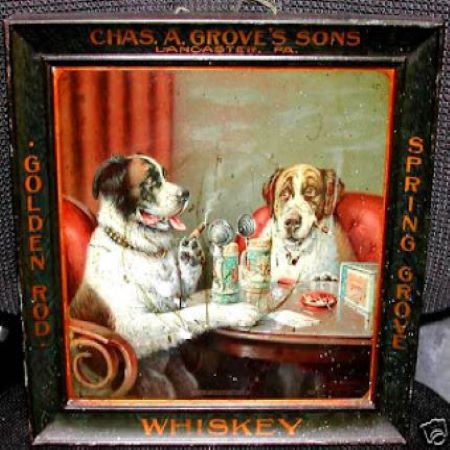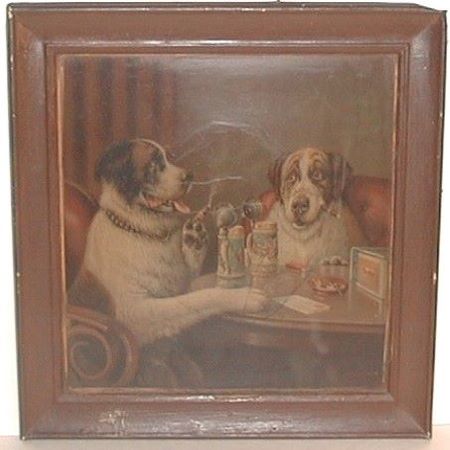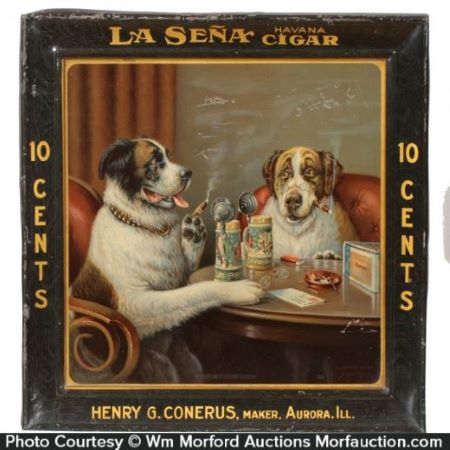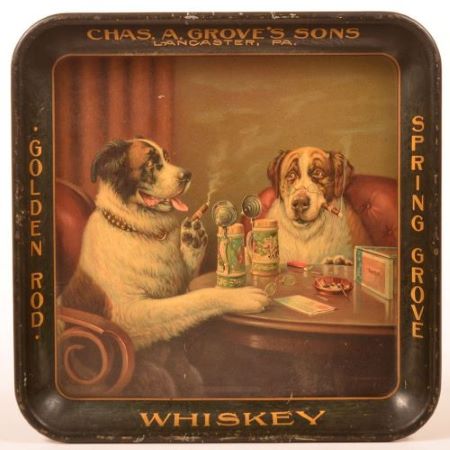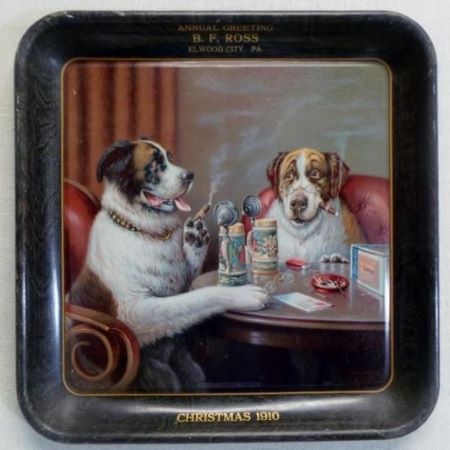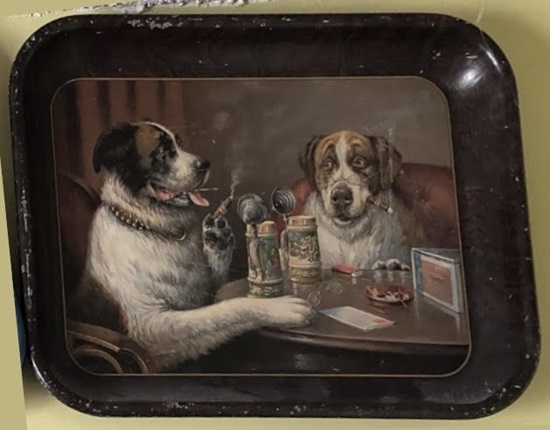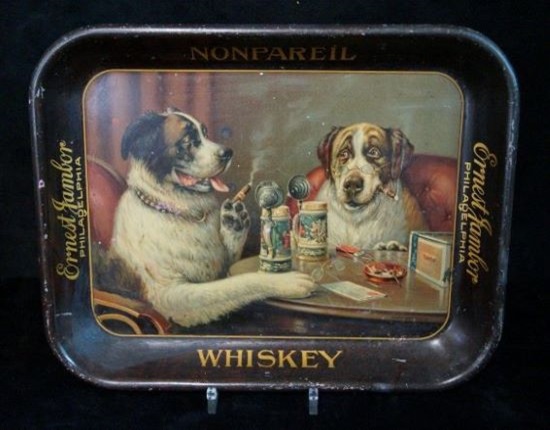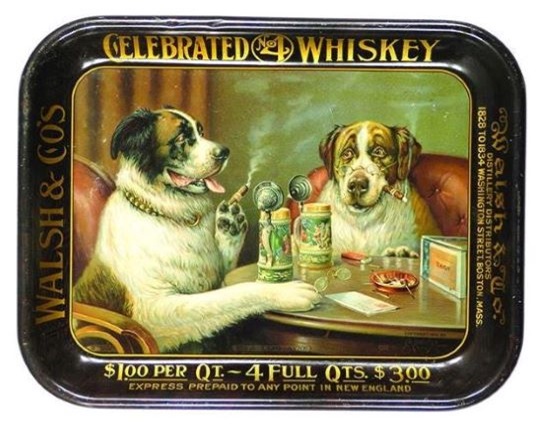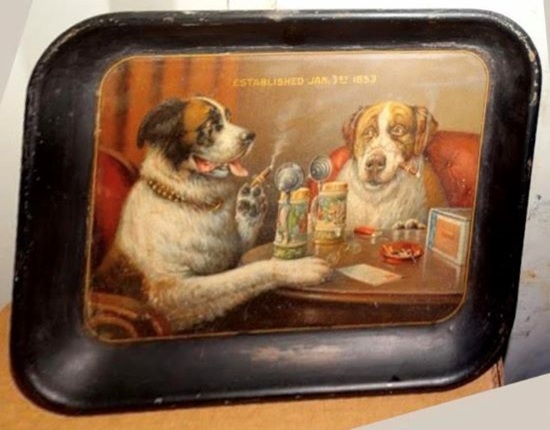The 'Stock' Exchange
American Art Works No. 107 "Auld Lang Syne"
American Art Works No. 107 "Auld Lang Syne"
Date: 1910 - 1913
Size: 13.25" x 13.25"
13.25" x 10.5"
Style: Pie
Scarcity: Common
Value: $$$ to $$$$
Condition & Brewer Dependent
Size: 13.25" x 13.25"
13.25" x 10.5"
Style: Pie
Scarcity: Common
Value: $$$ to $$$$
Condition & Brewer Dependent
General Comments
No. 107, “Auld Lange Syne” is based on a work by an outside artist, C. M. Coolidge, which was apparently commissioned by American Art Works for this design. His signature, as C M Coolidge, appears on most examples. This is probably the most whimsical design in the entire Coshocton catalog; such designs were much more common on advertising ephemera than on larger, more expensive pieces like trays and signs. Although the dogs in this design are not playing poker as in Coolidge’s more well-known works, the concept of anthropomorphized dogs engaging in the human activities of smoking cigars and drinking beers have precedence in the Dogs Playing Poker series.
The artist, Cassius Marcellus Coolidge (September 18, 1844 – January 13, 1934) was an American mainly known for his series of paintings Dogs Playing Poker, which refers collectively to an 1894 painting, a 1903 series of sixteen oil paintings commissioned by Brown & Bigelow to advertise cigars, and a 1910 painting. All eighteen paintings in the overall series feature anthropomorphized dogs, but the eleven in which dogs are seated around a card table have become well known in the United States as examples of kitsch art in home decoration. Coolidge was born to an Amish farm family in New York and had little formal art training.
Coolidge began his art career in his twenties, one of his early jobs being the creation of cartoons for a local newspaper. He is credited with creating "comic foregrounds," novelty photographs which combined a portrait of the sitter with a caricatured body, produced by the sitter holding between two sticks a canvas on which Coolidge drew or painted the caricature, which he patented. The final product was similar to the photographs produced using photo stand-ins at midways and carnivals where people place their heads into openings in life-size caricatures.
According to the advertising firm Brown & Bigelow, then primarily a producer of advertising calendars, Coolidge began his relationship with the firm in 1903. From the mid-1900s to the mid-1910s, Coolidge created a series of sixteen oil paintings for them, all of which featured anthropomorphic dogs, including nine paintings of Dogs Playing Poker, a motif that Coolidge is credited with inventing. Depictions and reenactments of the series have appeared in many films, television shows, theater productions, and other popular culture art forms, including: Cheers, The Simpsons, Roseanne, The Thomas Crown Affair, Police Academy 2, That 70s Show, The Far Side, Law & Order, The Family Guy, The Accountant, and at least two Snoop Dog videos.
As for the title, 'Auld Lang Syne' is a well-known Scottish song that dates from the mid-17th century, but was popularized by poet Robert Burns into the version we know today. Literally translated it means “long time since” which is understood to mean something like “old times, especially times fondly remembered,” or “old or long friendship.” Clearly that’s what this design is meant to convey, which is not a bad concept for advertising a product like beer and the design was especially popular with brewers. The lyric “We’ll tak a cup o’ kindness yet” refers to raising a glass, while “and “usurely ye’ll be your pint-stowp / and surely I’ll be mine” is another drinking line that is reflected in the design with each dog having his own stein.
Sahling has a workbook entry for “Auld Lang Syne square tray” in March of 1910. He uncharacteristically didn’t indicate a stock number, but even more unusually didn’t indicate that it was a stock design.
Size & Shape and Advertising Placement
As a tray this shows up most frequently as a square, although small oblongs (11x14) are also fairly common. The oblongs feature a somewhat cropped version of the full image indicating that the original design was intended to be square. A tip tray variation also occurs, though this is usually just the close up of dog on the right. We also have seen one example of a square self-framed-tin sign. At least one example we’ve encounter (West End Brewing; Utica, NY) carries NY Importing instead of American Art Works.
Hager & Price
Hager does not discuss this design other than to place its introduction in 1910 in his date table, but he does include it in his catalog. Although popular, prices for this design are not especially strong comparatively. Brewery examples do tend to fare much better than non-breweries, whose prices rarely command more than double digits.
No. 107, “Auld Lange Syne” is based on a work by an outside artist, C. M. Coolidge, which was apparently commissioned by American Art Works for this design. His signature, as C M Coolidge, appears on most examples. This is probably the most whimsical design in the entire Coshocton catalog; such designs were much more common on advertising ephemera than on larger, more expensive pieces like trays and signs. Although the dogs in this design are not playing poker as in Coolidge’s more well-known works, the concept of anthropomorphized dogs engaging in the human activities of smoking cigars and drinking beers have precedence in the Dogs Playing Poker series.
The artist, Cassius Marcellus Coolidge (September 18, 1844 – January 13, 1934) was an American mainly known for his series of paintings Dogs Playing Poker, which refers collectively to an 1894 painting, a 1903 series of sixteen oil paintings commissioned by Brown & Bigelow to advertise cigars, and a 1910 painting. All eighteen paintings in the overall series feature anthropomorphized dogs, but the eleven in which dogs are seated around a card table have become well known in the United States as examples of kitsch art in home decoration. Coolidge was born to an Amish farm family in New York and had little formal art training.
Coolidge began his art career in his twenties, one of his early jobs being the creation of cartoons for a local newspaper. He is credited with creating "comic foregrounds," novelty photographs which combined a portrait of the sitter with a caricatured body, produced by the sitter holding between two sticks a canvas on which Coolidge drew or painted the caricature, which he patented. The final product was similar to the photographs produced using photo stand-ins at midways and carnivals where people place their heads into openings in life-size caricatures.
According to the advertising firm Brown & Bigelow, then primarily a producer of advertising calendars, Coolidge began his relationship with the firm in 1903. From the mid-1900s to the mid-1910s, Coolidge created a series of sixteen oil paintings for them, all of which featured anthropomorphic dogs, including nine paintings of Dogs Playing Poker, a motif that Coolidge is credited with inventing. Depictions and reenactments of the series have appeared in many films, television shows, theater productions, and other popular culture art forms, including: Cheers, The Simpsons, Roseanne, The Thomas Crown Affair, Police Academy 2, That 70s Show, The Far Side, Law & Order, The Family Guy, The Accountant, and at least two Snoop Dog videos.
As for the title, 'Auld Lang Syne' is a well-known Scottish song that dates from the mid-17th century, but was popularized by poet Robert Burns into the version we know today. Literally translated it means “long time since” which is understood to mean something like “old times, especially times fondly remembered,” or “old or long friendship.” Clearly that’s what this design is meant to convey, which is not a bad concept for advertising a product like beer and the design was especially popular with brewers. The lyric “We’ll tak a cup o’ kindness yet” refers to raising a glass, while “and “usurely ye’ll be your pint-stowp / and surely I’ll be mine” is another drinking line that is reflected in the design with each dog having his own stein.
Sahling has a workbook entry for “Auld Lang Syne square tray” in March of 1910. He uncharacteristically didn’t indicate a stock number, but even more unusually didn’t indicate that it was a stock design.
Size & Shape and Advertising Placement
As a tray this shows up most frequently as a square, although small oblongs (11x14) are also fairly common. The oblongs feature a somewhat cropped version of the full image indicating that the original design was intended to be square. A tip tray variation also occurs, though this is usually just the close up of dog on the right. We also have seen one example of a square self-framed-tin sign. At least one example we’ve encounter (West End Brewing; Utica, NY) carries NY Importing instead of American Art Works.
Hager & Price
Hager does not discuss this design other than to place its introduction in 1910 in his date table, but he does include it in his catalog. Although popular, prices for this design are not especially strong comparatively. Brewery examples do tend to fare much better than non-breweries, whose prices rarely command more than double digits.


Confirmed Brewer used Stock Trays
Non-Beer Related & Non-Tray Uses
Click the Picture to Return to Meek & Beach Stock Catalog Page
